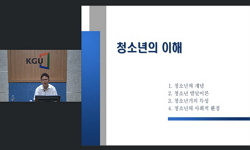이 연구는 청소년들의 비행이 가정 환경과 어떤 관계가 있는지를 알기 위하여, 비행청소년과 일반청소년의 가정 환경에 대한 인식 차이를 밝혀내기 위해 수행되었다. 이를 위하여 교도소에...
http://chineseinput.net/에서 pinyin(병음)방식으로 중국어를 변환할 수 있습니다.
변환된 중국어를 복사하여 사용하시면 됩니다.
- 中文 을 입력하시려면 zhongwen을 입력하시고 space를누르시면됩니다.
- 北京 을 입력하시려면 beijing을 입력하시고 space를 누르시면 됩니다.
비행청소년과 일반청소년의가정 환경 인식 비교 = (A) comparative study of the difference between normal youths' and juvenile delinquents' perception of their home environments
한글로보기https://www.riss.kr/link?id=T8428250
- 저자
-
발행사항
[아산] : 순천향대학교 산업정보대학원, 2000
-
학위논문사항
학위논문(석사) -- 순천향대학교 산업정보대학원 , 교육과학과 사회교육 전공 , 2000. 8
-
발행연도
2000
-
작성언어
한국어
- 주제어
-
KDC
370.18 판사항(4)
-
발행국(도시)
충청남도
-
형태사항
57p. ; 26cm .
-
일반주기명
참고문헌: p. 49-51
- 소장기관
-
0
상세조회 -
0
다운로드
부가정보
국문 초록 (Abstract)
이를 위하여 교도소에 수감중인 비행청소년 집단과 일반청소년 집단을 대상으로 가정의 환경, 부모와의 관계, 그리고 부모의 교육 정도와 청소년 비행과의 관계를 조사하였다.
조사 설문지는 청소년 가정 환경에 관한 25개 문항을 비행청소년과 일반 청소년, 두 집단에 동일한 설문지를 통한 결과의 차이를 비교 분석하여 통계처리 하였으며 조사 대상은 천안 소년원 150명과 천안시에 거주하는 동일 연령권내 고등학생과 대학생 150명 이였다. 회수된 설문지의 자료 처리는 SAS 프로그램을 이용하여 실시하였고, 통계 검증을 위한 유의 수준은 1%, 5%로 설정하였다.
이 연구를 통하여 얻어진 결과는 다음과 같다.
첫째, 가정 환경에 있어서 일반청소년에 비해 비행청소년 집단에서 결손 가정이 많은 것으로 나타났다.
둘째, 두 집단의 부모의 관심과 신뢰 정도, 대화의 정도, 가족들의 화목의 차이에서는 일반청소년에 비해 비행청소년들이 부모의 사랑과 애정, 신뢰를 받지 못하고 있는 것으로 나타났다.
셋째, 일반청소년 집단에 비해 비행청소년 집단의 부모는 자녀 교육에 소홀한 것으로 나타났다.
이 연구에서 일반청소년이 비행청소년보다 가정환경 인식에 있어서 긍정적인 결과가 나타난 것으로 보아 가정 환경이 청소년들의 비행 및 일탈 행위에 영향을 미치고 있음을 추론할 수 있다.
따라서, 올바른 청소년 지도를 위해서는 가정의 의미와 중요성에 대한 교육, 가족간에 신뢰와 화목 유지, 자녀와의 대화 촉진, 그리고 부모가 자녀에게 바른 삶을 보여 주는 등 가정환경의 적극적인 개선이 필요하다 하겠다.
이 연구는 청소년들의 비행이 가정 환경과 어떤 관계가 있는지를 알기 위하여, 비행청소년과 일반청소년의 가정 환경에 대한 인식 차이를 밝혀내기 위해 수행되었다.
이를 위하여 교도소에 수감중인 비행청소년 집단과 일반청소년 집단을 대상으로 가정의 환경, 부모와의 관계, 그리고 부모의 교육 정도와 청소년 비행과의 관계를 조사하였다.
조사 설문지는 청소년 가정 환경에 관한 25개 문항을 비행청소년과 일반 청소년, 두 집단에 동일한 설문지를 통한 결과의 차이를 비교 분석하여 통계처리 하였으며 조사 대상은 천안 소년원 150명과 천안시에 거주하는 동일 연령권내 고등학생과 대학생 150명 이였다. 회수된 설문지의 자료 처리는 SAS 프로그램을 이용하여 실시하였고, 통계 검증을 위한 유의 수준은 1%, 5%로 설정하였다.
이 연구를 통하여 얻어진 결과는 다음과 같다.
첫째, 가정 환경에 있어서 일반청소년에 비해 비행청소년 집단에서 결손 가정이 많은 것으로 나타났다.
둘째, 두 집단의 부모의 관심과 신뢰 정도, 대화의 정도, 가족들의 화목의 차이에서는 일반청소년에 비해 비행청소년들이 부모의 사랑과 애정, 신뢰를 받지 못하고 있는 것으로 나타났다.
셋째, 일반청소년 집단에 비해 비행청소년 집단의 부모는 자녀 교육에 소홀한 것으로 나타났다.
이 연구에서 일반청소년이 비행청소년보다 가정환경 인식에 있어서 긍정적인 결과가 나타난 것으로 보아 가정 환경이 청소년들의 비행 및 일탈 행위에 영향을 미치고 있음을 추론할 수 있다.
따라서, 올바른 청소년 지도를 위해서는 가정의 의미와 중요성에 대한 교육, 가족간에 신뢰와 화목 유지, 자녀와의 대화 촉진, 그리고 부모가 자녀에게 바른 삶을 보여 주는 등 가정환경의 적극적인 개선이 필요하다 하겠다.
다국어 초록 (Multilingual Abstract)
The subjects of the research were two groups of youths of the same ages, that is, a group of 150 juvenile delinquents in Chunan Youths Penitentiary and another group of 150 high school students and college students. The two subject groups were asked to fill out a set of survey questionnaires with 25 questions concerning the home environments. The results of the survey were statistically processed with SAS after x²(chi square) verification of the data. The degree of meaningfulness for the data verification was set to be 1% and 5%. The following were revealed from the survey research:
First, the group of juvenile delinquents were found to have much more family problems than the group of normal youths. This implies that juvenile delinquency is closely tied to problematic families: youths can easily fall into juvenile delinquency when they are alienated from their family due to such family problems as the parents' divorce and family disputes.
Second, juvenile delinquents were found to receive less affection, less trust or less care from their parents than normal youths.
Third, juvenile delinquents' parents were found to be more negligent in their children's education than normal youths' parents. They were also found to fail to become role models for their children, letting them to easily fall into juvenile delinquency.
On the basis of the result of the survey that normal youths show better perception of their home environment than juvenile delinquents, we can conclude that home environment is very significant in the youths' development: it exerts a great influence on their behavior. In order to promote healthy youth development, various efforts should be made to improve home environments, to educate the significance of family values, to restore the trust and harmony among family members, to increase conversation between the parents and the children, and to play role models for the children.
The purpose of this research is to investigate the relationship between juvenile delinquency and the home environments on the basis of the difference between normal youths' and juvenile delinquents' perception of their own home environments. Particula...
The purpose of this research is to investigate the relationship between juvenile delinquency and the home environments on the basis of the difference between normal youths' and juvenile delinquents' perception of their own home environments. Particularly, a group of juvenile delinquent inmates and a group of normal youths are compared with each other with respect to the home environments, the relationship with their parents, and the parents' educational background.
The subjects of the research were two groups of youths of the same ages, that is, a group of 150 juvenile delinquents in Chunan Youths Penitentiary and another group of 150 high school students and college students. The two subject groups were asked to fill out a set of survey questionnaires with 25 questions concerning the home environments. The results of the survey were statistically processed with SAS after x²(chi square) verification of the data. The degree of meaningfulness for the data verification was set to be 1% and 5%. The following were revealed from the survey research:
First, the group of juvenile delinquents were found to have much more family problems than the group of normal youths. This implies that juvenile delinquency is closely tied to problematic families: youths can easily fall into juvenile delinquency when they are alienated from their family due to such family problems as the parents' divorce and family disputes.
Second, juvenile delinquents were found to receive less affection, less trust or less care from their parents than normal youths.
Third, juvenile delinquents' parents were found to be more negligent in their children's education than normal youths' parents. They were also found to fail to become role models for their children, letting them to easily fall into juvenile delinquency.
On the basis of the result of the survey that normal youths show better perception of their home environment than juvenile delinquents, we can conclude that home environment is very significant in the youths' development: it exerts a great influence on their behavior. In order to promote healthy youth development, various efforts should be made to improve home environments, to educate the significance of family values, to restore the trust and harmony among family members, to increase conversation between the parents and the children, and to play role models for the children.
목차 (Table of Contents)
- 국문요약 = 8
- 제Ⅰ장 서론 = 10
- 1. 연구의 필요성과 목적 = 10
- 2. 연구의 문제 = 11
- 3. 용어의 정의 = 11
- 국문요약 = 8
- 제Ⅰ장 서론 = 10
- 1. 연구의 필요성과 목적 = 10
- 2. 연구의 문제 = 11
- 3. 용어의 정의 = 11
- 4. 연구의 제한점 = 12
- 제Ⅱ장 이론적 배경 = 13
- 1. 청소년 및 청소년 비행의 개념 = 13
- 2. 청소년 비행 관련 이론 = 16
- 3. 청소년 비행 실태 = 25
- 4. 선행 연구 고찰 = 26
- 제Ⅲ장 연구 방법 = 31
- 1. 조사 대상 = 31
- 2. 조사 도구 = 32
- 3. 자료의 처리 = 32
- 제Ⅳ장 연구 결과 및 해석 = 33
- 1. 가족 형태 차이 분석 = 33
- 2. 부모와의 관계 차이 분석 = 34
- 3. 가정 화목 정도 차이 분석 = 36
- 4. 여가시간 활용 형태 차이 분석 = 39
- 5. 부모의 가정 교육 정도 차이 분석 = 40
- 6. 가정의 중요성 인식 차이 분석 = 41
- 7. 가정 생활의 주된 고민 차이 분석 = 42
- 8. 행복의 조건 차이 분석 = 43
- 9. 가정 생활 만족도 차이 분석 = 44
- 10. 가정 교육과 청소년 비행 예방과의 관계 차이 분석 = 44
- 제Ⅴ장 결론 및 제언 = 46
- 1. 결론 = 46
- 2. 제언 = 47
- 참고문헌 = 49
- ABSTRACT = 52
- 부록 = 54












